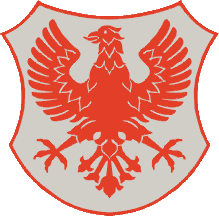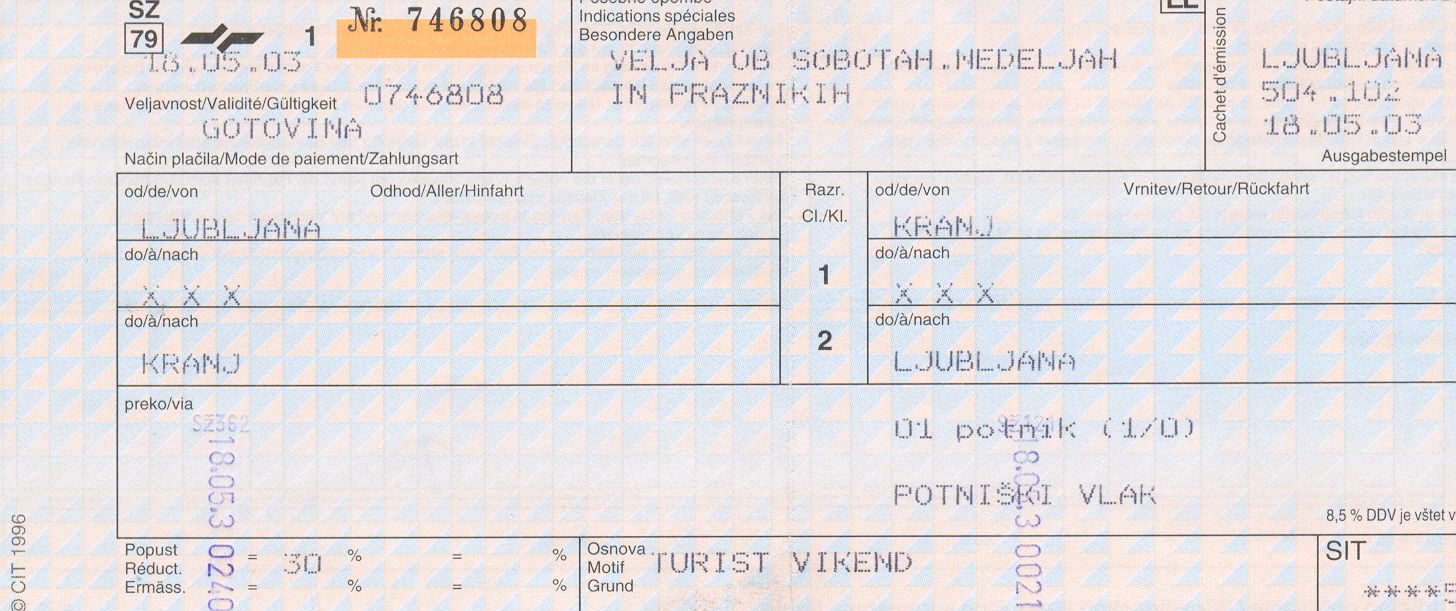Kranj
I had wanted to do some exploring of the Slovenian countryside, so on Sunday afternoon, I hopped a train to Kranj. I purchased my ticket at the Ljubljana train station; it only cost SIT 576, which was much cheaper than I was expecting. I think I received a 30% discount because I was traveling on the weekend. The national rail company, Slovenske Železnice, operates several frequencies between the two cities. I rode on one of the newer trains, which is shown in a picture below.
|
|
|
| The shiny, new red engine of Slovenske Železnice | My round-trip ticket between Ljubljana and Kranj. |
 Located about 30
kilometers northwest of Ljubljana, Kranj is the nation's fourth largest
city. It is the capital of the Gorenjska region and home to a number of
industrial factories. Kranj was founded on a secondary Roman road that
linked Emona (Ljubljana) with Virunum (near present-day Klagenfurt, Austria);
this
road was used until the 5th c. CE. About a century later, the
Lombards arrived and inhabited the region until they migrated west to northern
Italy. Next to arrive were the Slavs. In the 11th c. CE,
Kranj served as an important military post for Frankish counts as they defended
their territory against Magyar incursions. By the 13th c. CE,
Kranj was granted township status, confirming its stature as an important market
and religious center. Once iron mining developed in the surrounding
mountains, foundries came to the city. This started the industrialization
of the region; a trend that continues today.
Located about 30
kilometers northwest of Ljubljana, Kranj is the nation's fourth largest
city. It is the capital of the Gorenjska region and home to a number of
industrial factories. Kranj was founded on a secondary Roman road that
linked Emona (Ljubljana) with Virunum (near present-day Klagenfurt, Austria);
this
road was used until the 5th c. CE. About a century later, the
Lombards arrived and inhabited the region until they migrated west to northern
Italy. Next to arrive were the Slavs. In the 11th c. CE,
Kranj served as an important military post for Frankish counts as they defended
their territory against Magyar incursions. By the 13th c. CE,
Kranj was granted township status, confirming its stature as an important market
and religious center. Once iron mining developed in the surrounding
mountains, foundries came to the city. This started the industrialization
of the region; a trend that continues today.
I arrived in Kranj's railway station at 15.30. The station is located about ˝ kilometer from the center of the city, which is accessed by crossing a bridge over the Sava River. The river is quite wide with a fairly rapid current. As I crossed, I noticed a couple of anglers fly-fishing near the outlet from a mill. I thought of Tom and my dad fly-fishing in the Arkansas River in Colorado.
|
|
|
Mill effluent into the Sava River at Kranj |
Kranj appeared to be a sleepy town, much more quiet that Ljubljana; I didn't think that was possible, but it was. Most people were probably enjoying their Sunday afternoon with friends or family. The streets were fairly quiet, with little activity. The only congregations of people seemed to be occurring at the local cafés. In my opinion, this is not a bad way to spend the afternoon.
I decided to start at the southern edge of town and work my way northward. The first attraction was the Plague Church. This church was built in the 1470s to honor three saints who worked to eradicate the plague - Saints Rok, Fabian and Sebastian. The church now is used by the Serbian Orthodox Church for services. It was a rather non-descript building, so I did not enter. There is a courtyard to the west of the church that has some attractions and great southerly views. There was a festival occurring in the courtyard; it was some type of rock-climbing event for children, complete with several sets of small rock-climbing walls.
- At the southeast corner of the courtyard is a three-story tower
that formed Kranj's defensive wall. Built in the 16th century, it is
the only tower that remains from this network. Part of the defensive
walls can be seen just below the tower.
- At the tip of the courtyard, there is a great view of the Krka River, which merges with the Sava just south of Kranj. The river appeared to be fairly dry.
|
|
|
| The Plague Church, viewed from the south end of the courtyard. To the far right is some of the equipment used for the rock-climbing festival. | Remnants of the city's protective walls, located to the south of the Plague Church |
I headed north on the town's main street, Cankarjev ulica, until I reached Glavni trg. This appeared to the the town's main square, with a couple of landmarks facing it. Hidden on a side square is the entrance to the Prešeren Theater, honoring Kranj's favorite resident and a national hero. Dr France Prešeren was a prominent 19th c. CE lawyer and poet who wrote during the Slovene Romantic movement. Though he was not a prolific writer, his contributions to Slovene literature were significant. He spent the last years of his life in Kranj before dying in 1849 in this town. The most interesting part of the theater is the pink marbled front entry way.
There is a statue of Prešeren outside the theater with the following inscription at its base (I have no idea what it means. If you speak Slovene and can translate this passage, please email me.)
|
|
|
| A very stern-looking Dr France Prešeren | The theater's main entrance, which is surrounded by pink marble. |
Živé naj vsi naródi
Fri hrepené dočákat' dan,
De hóder sónce hódi,
Prepir ir soéta bó -pregrán,
De roják
Prost bo usák
Ne urág, le sósed bo meják
To the north of the Prešeren Theater and Monument is the Cerka Sveti Kancijan. Started around 1400, this church is dedicated to Saint Cantianus. According to a website on saint feast days, Saint Cantianus, along with his brother and sister, came from a prominent Roman family, the Anicii. Orphaned, the three children were taught the Christian faith by their guardian, Protus. When Emperor Diocletian started his persecution of Christians in the 4th c. CE, the four decided to flee to Aquilea in present-day France. Because they came from such a prominent family, the four were pursued and caught. When they refused to offer sacrifices to the civic pagan gods, all four were beheaded. For their martyrdom, all four were rewarded posthumous sainthood. Their feast day is celebrated on 31-May.
The interior of the church was set up for a wedding, so I did not enter it. On the south face are a number of medieval headstones from a cemetery that was located to the north of the church. Also on this side is a statue of Saint John Nepomucen, as he is being dunked into the river. Saint John was a 14th c. CE Bohemian martyr who refused a request from his emperor to grant approval to convert an abbey into a cathedral.
Just north of the church is the Gorenjska Muzej Kranj. The building once served as the town hall, but now hosts the regional museum. The town hall actually is an amalgamation of two separate houses. The first house is mentioned in town records as early as the 16th c. CE, while the second, constructed in the Renaissance style, originates from the 17th c. CE. A vestige of the former use can be seen in a room on the second floor - it appears to be a reconstruction of the council chamber, with its wooden Renaissance ceiling and wooden portals. The museum presents the history of the region through pictures, sculpture and archaeological exhibits. Most of the exhibits are sign-posted in English and Slovene. Probably the most interesting exhibit is the 9th c. CE early Slavic bones that are encased under the the first floor. There is a glass floor that allows the visitor to view the grave. Entrance to the museum costs SIT 500, but is free on Sundays.
|
|
|
| The façade of the Gorenjska Muzej Kranj. This is the former house constructed in the Renaissance style. | A trunk to store clothes and blankets, typical of eastern European countries |
There is a fountain located in the northwest corner of Glavni trg. Crowning the top is a gold statue of the eagle that appears on the city's crest. I proceeded north on Prešerenova ulica to the town's northernmost square - Maistrov trg. In the 15th c. CE, it was the site of the town's upper, and most vulnerable, gate. Now it hosts a number of cafés and bars. The road leading north takes visitors to the town's residential areas.
I headed south on Tomšičeva ulica, which runs parallel to the main street. At the lower end of this street is the Khilslstein Castle. It was built in the 15th c. CE as part of the structure to defend against the Turkish invasion. The castle was purchased in the 16th c. CE by Slovenian industrialist Janž Khisl, for whom the castle now is named. Today it houses the folk art collection of the previously-visited Gorenjska Muzej Kranj. It was closed so I wasn't able to enter the building or the courtyard.
I had a few minutes to spare, so I went to the western edge of the city. From the bridge that crosses the Krka River, I filmed a panoramic view of the Julian Alps. I then headed back to the train station to catch the 17.21 train back to Ljubljana. Kranj is a quaint town that is worth a couple-hour visit. I wouldn't make a special trip to see it, rather make it part of a tour from the capital city.
Return to Slovenia main page
or Trips Database main page
